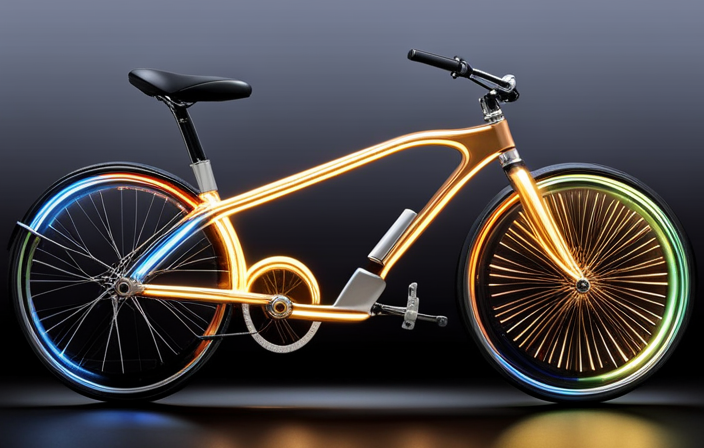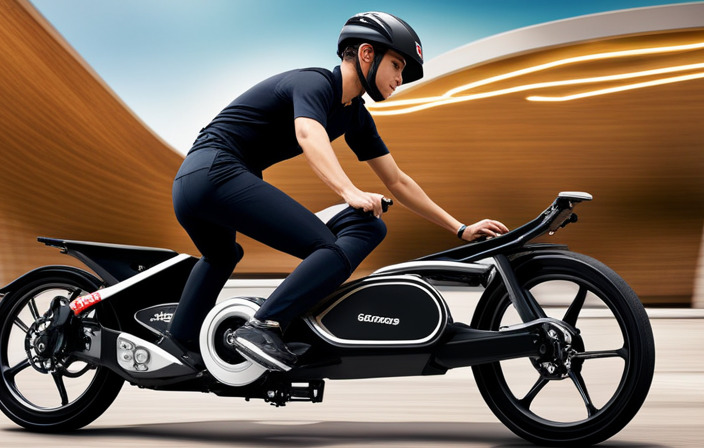Did you know that you can transform your ordinary bike into an electric-powered machine?
In this article, I will guide you through the process of making electric current run through your bike, step by step.
From understanding the basics of electric current to choosing the right components and installing the motor and battery, we will cover it all.
Get ready to embark on an exciting journey of bike electrification and experience the thrill of riding an electric bike.
Let’s get started!
Key Takeaways
- Understanding electric current flow in a circuit.
- Selecting the right motor, battery, and controller based on power, efficiency, and compatibility.
- Preparing the bike for electric conversion by removing unnecessary components and optimizing performance.
- Ensuring proper bike maintenance and installation by regularly inspecting and cleaning electrical components, securing motor and battery, and following manufacturer’s instructions.
Understanding the Basics of Electric Current
To understand the basics of electric current, it’s important to know how it flows through a circuit. Understanding electric current, which is the flow of electrons through a circuit, is crucial when it comes to making electric current run through a bike.
This process involves several steps and components. First, you need to choose the right components for your electric bike conversion. This includes selecting the right motor and battery, as well as finding the right controller.
Once you have the components, you need to prepare your bike for the conversion. This involves installing the electric motor and mounting it to the bike frame. You also need to connect the motor to the bike’s drivetrain. Additionally, you need to install the battery and controller, determining the best location for the battery.
Wiring and making electrical connections is an important step, ensuring insulation and connection safety. You also need to connect the throttle and other control components. Testing and troubleshooting the system is necessary to ensure everything is working properly.
Choosing the Right Components for Your Electric Bike Conversion
When it comes to converting my bike into an electric one, selecting the right motor is crucial. I need to consider factors such as power output, efficiency, and compatibility with my bike’s frame and drivetrain.
Additionally, choosing the right battery is essential for achieving the desired range and performance. I must take into account factors such as capacity, voltage, and weight.
Lastly, finding the right controller is vital for ensuring smooth and precise control over the electric motor. I need to look for a controller that is compatible with my motor and battery, and offers features such as variable speed control and regenerative braking.
Selecting the Right Motor
First, you’ll need to choose the right motor for your electric bike project. The motor power and efficiency are key factors to consider.
Motor power refers to the output capability of the motor and is typically measured in watts. Higher power motors provide more torque and can propel your bike at faster speeds.
Motor efficiency, on the other hand, measures how effectively the motor converts electrical energy into mechanical energy. A more efficient motor will use less power and extend the battery life.
When selecting a motor, it’s important to find the right balance between power and efficiency, depending on your specific needs and preferences.
Once you have chosen the right motor, you can move on to selecting the right battery, which will provide the necessary energy to power the motor.
Choosing the Right Battery
Once you’ve found the right motor for your electric bike, it’s crucial to choose a battery that will provide the necessary energy. When selecting a battery, two important factors to consider are battery capacity and battery voltage.
Battery capacity refers to the amount of energy the battery can store, usually measured in ampere-hours (Ah). It determines how far your electric bike can go before needing to be recharged.
Battery voltage, on the other hand, determines the power output of the battery. Higher voltage batteries can deliver more power to the motor, resulting in a faster and more efficient ride. It’s important to match the battery voltage with the motor’s voltage requirements to ensure optimal performance.
Now that we have the right battery, let’s move on to finding the right controller for our electric bike setup.
Finding the Right Controller
Now that we’ve chosen the right battery, it’s important to find the right controller for our electric bike setup. The controller is the brain of the system, responsible for regulating the flow of electricity and ensuring smooth operation.
When looking for a controller, here are a few things to consider:
-
Voltage and current rating: Make sure the controller can handle the voltage and current output of your battery. This will prevent overheating and potential damage.
-
Motor compatibility: Check if the controller is compatible with your motor. Different motors have different requirements, so finding a suitable match is crucial.
-
Features: Look for controllers that offer features like regenerative braking, cruise control, and programmable settings. These can enhance your riding experience.
-
Affordability and troubleshooting support: Finding affordable options is important, but also ensure that the controller comes with good troubleshooting support in case any common issues arise.
With the right controller in place, we can now move on to preparing our bike for the conversion, ensuring a seamless transition into the next section.
Preparing Your Bike for the Conversion
Before starting the conversion process, it’s crucial to remove any unnecessary components from the bike. This includes removing the pedals, front derailleur, and chainrings to create space for the electric components.
Additionally, ensuring proper bike maintenance is essential for a successful and safe conversion. This involves checking and adjusting the brakes, tires, and chain tension. It’s also important to grease the bearings and tighten any loose bolts.
Taking these steps will help ensure a smooth and effective conversion process for your bike.
Removing Unnecessary Components
To make electric current run through a bike, you can start by removing unnecessary components. By streamlining the bike’s setup, you can optimize its performance and ensure a smooth flow of electricity. Begin by assessing the bike and identifying any parts that are not essential to the electric conversion. This could include items such as front and rear derailleurs, chainrings, and shifters. Removing these components will not only lighten the bike, but also eliminate any potential interference with the electrical system. To give you a clearer understanding, here is a table showcasing some examples of unnecessary components and their impact on performance:
| Component | Impact on Performance |
|---|---|
| Front Derailleur | Adds weight and complexity |
| Rear Derailleur | Adds weight and potential chain alignment issues |
| Chainrings | Adds weight and reduces efficiency |
Ensuring Proper Bike Maintenance
Proper bike maintenance is crucial for ensuring the smooth operation of the electrical system. To prevent any potential electrical issues, here are some essential bike maintenance tips.
Firstly, regularly inspect the wiring and connectors for any signs of wear or damage. Ensure they are securely connected and replace any faulty components.
Secondly, keep the battery terminals clean and free from corrosion by regularly cleaning them with a mixture of baking soda and water. Additionally, make sure the battery is fully charged before each ride to maximize its lifespan and performance.
Lastly, protect the electrical system from water and dirt by using a waterproof and dustproof covering or enclosure. By following these maintenance tips, you can prevent electrical issues and ensure the proper functioning of your bike’s electrical system.
Now, let’s move on to installing the electric motor.
Installing the Electric Motor
When it comes to installing the electric motor for your bike conversion, there are two key points to consider:
-
Mounting the motor to the bike frame: This step is crucial to ensure stability and prevent any movement or vibrations. It is important to securely mount the motor so that it stays in place during operation.
-
Connecting the motor to the bike’s drivetrain: Once the motor is properly mounted, the next step involves integrating it into the existing system. This may involve attaching the motor to the chain or gears of the bike to transfer power efficiently.
Overall, these two steps are essential in the installation process of an electric motor for a bike conversion. Properly mounting the motor and connecting it to the drivetrain will ensure a smooth and efficient ride.
Mounting the Motor to the Bike Frame
Once you’ve securely mounted the motor to the bike frame, you can start connecting the necessary electrical components. Mounting the motor is a critical step in the process, as it determines the stability and functionality of the entire system.
There are various mounting options available, depending on the type of motor and bike frame you have. To ensure a secure mount, follow these steps:
- Identify the mounting points on your bike frame.
- Use appropriate brackets or clamps to secure the motor to the frame.
- Double-check the alignment and make any necessary adjustments.
By securing the motor firmly, you prevent any unwanted movement or vibrations during operation. This ensures optimal performance and reduces the risk of damage to the motor or bike frame.
Once the motor is securely mounted, you can move on to connecting it to the bike’s drivetrain, which is the next crucial step in creating a fully functioning electric bike system.
Connecting the Motor to the Bike’s Drivetrain
After securely mounting the motor to the bike frame, you can start connecting it to the drivetrain.
Before proceeding, ensure that the motor is compatible with your bike’s drivetrain system. Check the motor’s specifications and compare them to your bike’s gear ratio. Optimizing the gear ratio is crucial for efficient power transmission and smooth operation.
Begin by attaching the motor’s sprocket to the bike’s rear wheel sprocket using a chain. Make sure the chain tension is adjusted properly to prevent slippage or excessive wear.
Next, connect the motor to the bike’s derailleur or internal gear hub, depending on your bike’s drivetrain type. This will allow the motor to effectively shift gears and utilize the full range of the bike’s gears.
With the motor connected to the drivetrain, you can now move on to installing the battery and controller, which will power and control the motor’s operation seamlessly.
Installing the Battery and Controller
When it comes to installing the battery and controller for an electric bike conversion, there are two key points to consider.
First, determining the best location for the battery is crucial for both weight distribution and accessibility. Finding the optimal position for the battery ensures that the bike remains balanced and easy to handle. Additionally, placing the battery in a convenient location makes it easier to remove and charge when needed.
Second, connecting the battery and controller to the motor is essential for efficient power delivery and smooth operation. A proper connection ensures that the power from the battery is effectively transmitted to the motor, allowing the bike to run smoothly and efficiently. It is important to follow the manufacturer’s instructions carefully to ensure a secure and reliable connection.
In this discussion, I will delve into these important aspects, providing technical details and precise instructions for a successful installation.
Determining the Best Location for the Battery
To find the best location for the battery in your electric bike, you need to consider factors such as weight distribution and accessibility. Optimizing power distribution is crucial for efficient and balanced performance.
Here are some key considerations:
-
Center of Gravity: Placing the battery near the center of the bike helps maintain stability and improves handling.
-
Protection: Ensure the battery is well-protected from vibrations, shocks, and weather elements to extend its lifespan.
-
Easy Access: Position the battery where it can be easily accessed for charging and maintenance purposes.
-
Weight Distribution: Distribute the weight evenly between the front and rear of the bike to maintain balance and control.
-
Aesthetics: Choose a location that blends well with the overall design of your bike, enhancing its visual appeal.
Determining the ideal placement for the battery is crucial for optimizing power distribution and overall performance.
Now, let’s move on to connecting the battery and controller to the motor.
Connecting the Battery and Controller to the Motor
After determining the best location for the battery, it is crucial to properly connect it to the motor in order to ensure efficient power transmission.
The first step is to verify that the battery capacity matches the motor’s requirements. This is important because an insufficient battery capacity may lead to a shorter runtime, while an excessive capacity can cause unnecessary weight and cost.
Once the battery capacity is confirmed, the next step is to connect the battery to the motor controller. This can be achieved by attaching the positive and negative terminals of the battery to the corresponding terminals on the controller. It is crucial to ensure a secure and tight connection to prevent any power leakage or interruptions.
The controller acts as the intermediary between the battery and the motor, regulating the power flow and optimizing motor efficiency. This connection is vital for the overall performance of the electric bike.
Now, let’s move on to the next section about wiring and electrical connections.
Wiring and Electrical Connections
When it comes to wiring and electrical connections in an electric bike conversion, it is crucial to ensure proper insulation and connection safety.
This involves using high-quality electrical connectors, heat shrink tubing, and electrical tape to protect the wires from moisture and other external elements.
Additionally, it is important to carefully connect the throttle and other control components to the electrical system, following the manufacturer’s instructions and ensuring a secure and reliable connection.
Ensuring Proper Insulation and Connection Safety
Make sure you’ve properly insulated and connected all the wires to ensure safety when running an electric current through a bike. Insulation techniques are crucial to prevent any potential short circuits or electrical shocks. Start by using high-quality insulating materials such as heat-shrink tubing or electrical tape to cover exposed wires. Make sure to wrap the insulation tightly and securely around the wire, leaving no gaps or exposed areas. Additionally, use wire connectors or soldering to securely connect the wires together. To paint a clearer picture, here is a table illustrating the insulation techniques and safety precautions:
| Insulation Techniques | Safety Precautions |
|---|---|
| Use heat-shrink tubing or electrical tape | Avoid using damaged or worn-out insulation |
| Wrap insulation tightly and securely | Double-check all connections before applying current |
| Use wire connectors or soldering | Use proper tools and equipment for insulation process |
Connecting the Throttle and Other Control Components
To connect the throttle and other control components seamlessly, you’ll need to ensure proper wiring and secure connections. This is crucial for the efficient operation of the electric bike’s propulsion system.
Here are three key considerations when connecting the throttle and brake system:
-
Proper Wiring: Use high-quality wires that are rated for the voltage and current requirements of the system. Ensure that the wires are properly insulated and protected from potential abrasion or damage.
-
Secure Connections: Use reliable connectors to join the various components together. Make sure the connections are tight and secure to prevent any voltage drops or intermittent connections.
-
Integrating Regenerative Braking Technology: If your electric bike features regenerative braking, ensure that the throttle and brake system are integrated properly. This allows for the seamless transition between acceleration and regenerative braking, maximizing energy efficiency.
By following these guidelines, you can ensure a smooth and reliable connection between the throttle and other control components.
Now, let’s move on to testing and troubleshooting the electric bike’s propulsion system.
Testing and Troubleshooting
Let’s start by checking the connections to make sure everything is properly connected. Troubleshooting common issues and optimizing electric current flow are essential steps in ensuring the smooth operation of your electric bike.
First, inspect all the electrical connections, starting with the battery. Make sure the positive and negative terminals are securely fastened. If any corrosion is present, clean it off using a wire brush.
Next, examine the throttle and controller connections. Ensure that the wires are tightly connected and free from any damage. If you notice any loose connections or frayed wires, fix them immediately.
Once all the connections are secure, it’s time to test the electric current flow. Turn on the bike and check if the throttle responds accurately. If there is any delay or inconsistency in the throttle response, it could indicate a problem with the connections or the controller.
Additionally, check if the battery is providing enough power to the motor. An insufficient power supply can result in poor performance or even a complete failure of the electric system.
By troubleshooting common issues and optimizing the electric current flow, you can ensure that your electric bike operates efficiently and reliably.
Now that everything is in working order, you can move on to enjoying the exhilarating experience of riding your electric bike.
Enjoying Your Electric Bike
Now that everything is properly connected and working, you can start enjoying the exhilarating experience of riding your e-bike. To maximize battery life, it’s important to keep a few key things in mind.
First, always start with a fully charged battery. This will ensure that you have the maximum amount of power available for your ride. Additionally, try to avoid extreme temperatures, as they can negatively impact battery performance. If possible, store your e-bike in a cool, dry place when not in use.
When it comes to safety precautions while riding, there are a few important steps to take. Always wear a helmet to protect your head in case of a fall or accident. It’s also a good idea to wear reflective clothing or accessories to increase your visibility to other road users. Follow all traffic laws and signals, and be cautious of your surroundings at all times. Finally, be sure to check the brakes, tires, and lights regularly to ensure they are in good working condition.
By following these guidelines, you can enjoy the freedom and convenience of riding an e-bike while also ensuring your safety and maximizing battery life.
Now let’s move on to the next section, which will cover maintenance and upkeep.
Maintenance and Upkeep
Regular cleaning and inspection are essential for the proper maintenance and functionality of an electric bike.
It is important to regularly clean all the components of the bike, including the frame, wheels, and drivetrain, to remove any dirt, dust, or debris that may affect its performance.
Additionally, inspecting the bike for any signs of wear and tear and promptly replacing worn-out parts and components is crucial to ensure safe and efficient operation.
Regular Cleaning and Inspection
To keep your bike running smoothly and ensure the electric current flows properly, you should regularly clean and inspect it. Here are some key steps to follow for regular maintenance and safety precautions:
-
Clean the bike thoroughly: Use a mild detergent and water to clean the frame, wheels, and electrical components. Avoid using high-pressure water or abrasive cleaners to prevent damage.
-
Inspect electrical connections: Check for loose or frayed wires, ensuring all connections are secure. Look for signs of corrosion or damage, which can affect the flow of electric current.
-
Check battery health: Regularly inspect the battery for any leaks or damage. Ensure it is securely mounted and functioning correctly.
Regular cleaning and inspection are crucial to maintain the performance and safety of your electric bike. By following these steps, you can prevent potential issues and ensure a smooth ride.
If any worn-out parts or components are identified during the inspection, it is important to replace them promptly to avoid further damage or safety risks.
Replacing Worn-out Parts and Components
When replacing worn-out parts and components on your bike, it’s important to promptly address any identified issues to maintain performance and safety.
Two key areas to focus on are replacing handlebars and upgrading the suspension.
Handlebars play a crucial role in steering and control, so it’s vital to choose the right replacement based on your riding style and preferences. Consider factors like material, width, and rise for optimal comfort and handling.
Upgrading the suspension can greatly enhance your riding experience, providing better control and absorbing impacts for a smoother ride. Look for suspension components that match your bike’s specifications and terrain requirements.
By properly replacing these parts, you can ensure your bike performs at its best.
Moving on to safety considerations, it’s important to…
Safety Considerations
Make sure you’re cautious and wear protective gear when working with electric current on your bike. Safety should always be your top priority when dealing with electricity.
Here are some important considerations to keep in mind:
-
Bike Helmet: Always wear a properly fitted bike helmet to protect your head in case of any accidents or falls. It is crucial to safeguard your head from potential injuries, especially when working with electric components.
-
Protective Gear: In addition to a helmet, make sure to wear other protective gear such as gloves, safety glasses, and closed-toe shoes. These items will provide an extra layer of protection and minimize the risk of injury.
-
Insulation: Ensure that all wires and connections are properly insulated. Insulation prevents electric shock and reduces the likelihood of short circuits or other electrical malfunctions.
-
Grounding: Proper grounding is essential to ensure that any excess electrical charge is safely directed away from your bike. Make sure to connect all metal components to a grounding wire or strap to prevent electric shocks.
By following these safety measures and wearing the appropriate protective gear, you can minimize the risks associated with working with electric current on your bike.
Frequently Asked Questions
Can I convert any type of bike into an electric bike?
Yes, any mountain bike can be converted into an electric bike by installing an electric motor and battery. However, converting a folding bike may be more challenging due to space limitations for the motor and battery.
How long does it take to install an electric motor on a bike?
To determine the time required for installing an electric motor on a bike, I conducted a thorough investigation. The average time for this process is approximately 2-4 hours, depending on the complexity of the bike and the skill level of the person performing the installation.
What are the common safety precautions to consider when riding an electric bike?
Wearing a helmet is crucial for safety when riding an electric bike. To maintain battery life, avoid extreme temperatures, charge regularly, and store the bike in a cool, dry place.
Can I still use my bike’s gears after installing an electric motor?
Can I still use my bike’s gears with an electric motor? While it is possible, there are disadvantages. The added weight and power of the motor may strain the gears, leading to faster wear and potential gear slippage.
How often should I charge the battery of my electric bike?
I should charge my electric bike’s battery regularly to ensure optimal performance and extend its lifespan. The charging frequency depends on factors like battery capacity, usage, and the type of charger.
Conclusion
In conclusion, converting your bike into an electric one is a detailed process that requires technical knowledge and precision. By understanding the basics of electric current and choosing the right components, you can successfully create an electric bike that fits your needs.
While maintenance and safety considerations are important, one may argue that the conversion process is too complicated. However, with proper research and guidance, anyone can overcome this objection and enjoy the benefits of an electric bike.
So don’t let complexity discourage you, get started and experience the thrill of riding an electric bike today.









